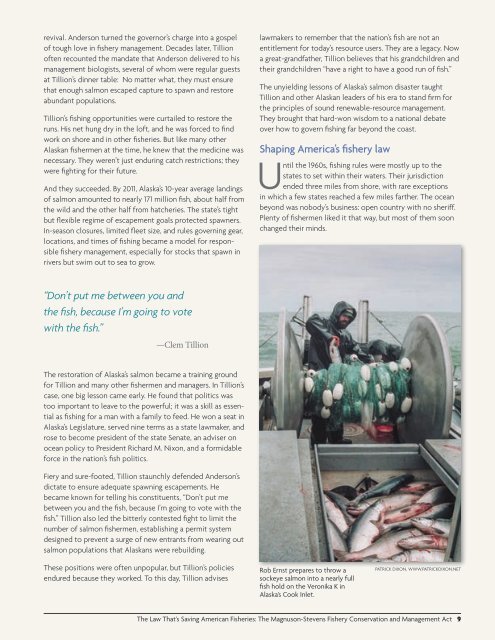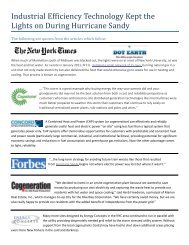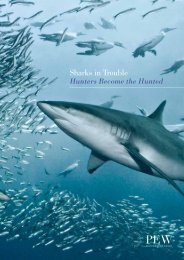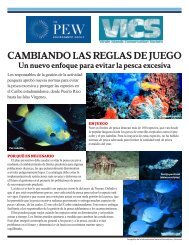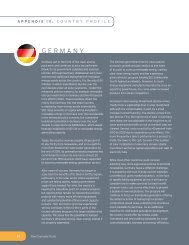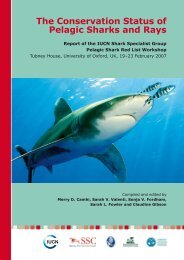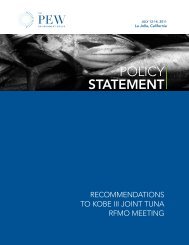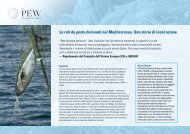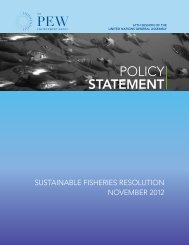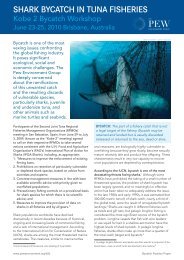The Law That's Saving American Fisheries - Ocean Conservancy
The Law That's Saving American Fisheries - Ocean Conservancy
The Law That's Saving American Fisheries - Ocean Conservancy
Create successful ePaper yourself
Turn your PDF publications into a flip-book with our unique Google optimized e-Paper software.
evival. Anderson turned the governor’s charge into a gospel<br />
of tough love in fishery management. Decades later, Tillion<br />
often recounted the mandate that Anderson delivered to his<br />
management biologists, several of whom were regular guests<br />
at Tillion’s dinner table: No matter what, they must ensure<br />
that enough salmon escaped capture to spawn and restore<br />
abundant populations.<br />
Tillion’s fishing opportunities were curtailed to restore the<br />
runs. His net hung dry in the loft, and he was forced to find<br />
work on shore and in other fisheries. But like many other<br />
Alaskan fishermen at the time, he knew that the medicine was<br />
necessary. <strong>The</strong>y weren’t just enduring catch restrictions; they<br />
were fighting for their future.<br />
And they succeeded. By 2011, Alaska’s 10-year average landings<br />
of salmon amounted to nearly 171 million fish, about half from<br />
the wild and the other half from hatcheries. <strong>The</strong> state’s tight<br />
but flexible regime of escapement goals protected spawners.<br />
In-season closures, limited fleet size, and rules governing gear,<br />
locations, and times of fishing became a model for responsible<br />
fishery management, especially for stocks that spawn in<br />
rivers but swim out to sea to grow.<br />
lawmakers to remember that the nation’s fish are not an<br />
entitlement for today’s resource users. <strong>The</strong>y are a legacy. Now<br />
a great-grandfather, Tillion believes that his grandchildren and<br />
their grandchildren “have a right to have a good run of fish.”<br />
<strong>The</strong> unyielding lessons of Alaska’s salmon disaster taught<br />
Tillion and other Alaskan leaders of his era to stand firm for<br />
the principles of sound renewable-resource management.<br />
<strong>The</strong>y brought that hard-won wisdom to a national debate<br />
over how to govern fishing far beyond the coast.<br />
Shaping America’s fishery law<br />
Until the 1960s, fishing rules were mostly up to the<br />
states to set within their waters. <strong>The</strong>ir jurisdiction<br />
ended three miles from shore, with rare exceptions<br />
in which a few states reached a few miles farther. <strong>The</strong> ocean<br />
beyond was nobody’s business: open country with no sheriff.<br />
Plenty of fishermen liked it that way, but most of them soon<br />
changed their minds.<br />
“Don’t put me between you and<br />
the fish, because I’m going to vote<br />
with the fish.”<br />
—Clem Tillion<br />
<strong>The</strong> restoration of Alaska’s salmon became a training ground<br />
for Tillion and many other fishermen and managers. In Tillion’s<br />
case, one big lesson came early. He found that politics was<br />
too important to leave to the powerful; it was a skill as essential<br />
as fishing for a man with a family to feed. He won a seat in<br />
Alaska’s Legislature, served nine terms as a state lawmaker, and<br />
rose to become president of the state Senate, an adviser on<br />
ocean policy to President Richard M. Nixon, and a formidable<br />
force in the nation’s fish politics.<br />
Fiery and sure-footed, Tillion staunchly defended Anderson’s<br />
dictate to ensure adequate spawning escapements. He<br />
became known for telling his constituents, “Don’t put me<br />
between you and the fish, because I’m going to vote with the<br />
fish.” Tillion also led the bitterly contested fight to limit the<br />
number of salmon fishermen, establishing a permit system<br />
designed to prevent a surge of new entrants from wearing out<br />
salmon populations that Alaskans were rebuilding.<br />
<strong>The</strong>se positions were often unpopular, but Tillion’s policies<br />
endured because they worked. To this day, Tillion advises<br />
Rob Ernst prepares to throw a<br />
sockeye salmon into a nearly full<br />
fish hold on the Veronika K in<br />
Alaska’s Cook Inlet.<br />
PATRICK Dixon, www.PATRICKDixon.net<br />
<strong>The</strong> <strong>Law</strong> That’s <strong>Saving</strong> <strong>American</strong> <strong>Fisheries</strong>: <strong>The</strong> Magnuson-Stevens Fishery Conservation and Management Act 9


